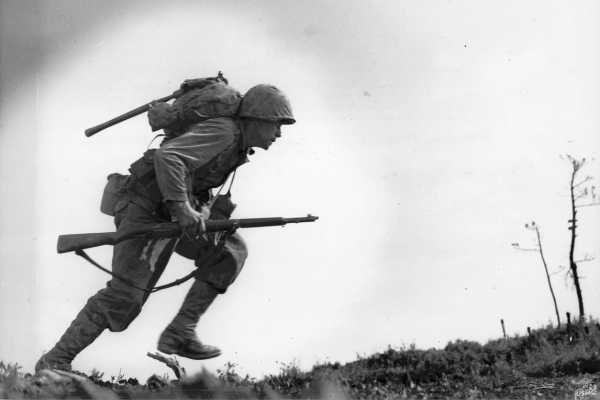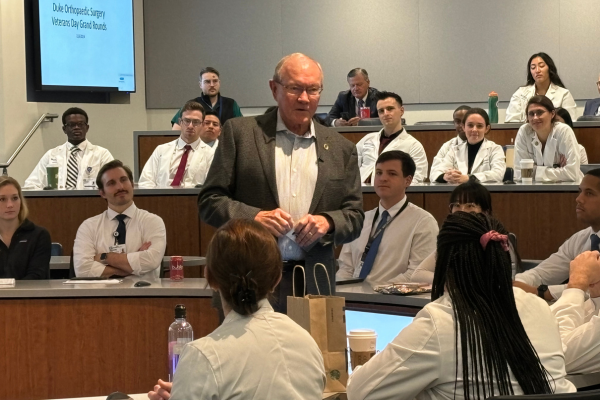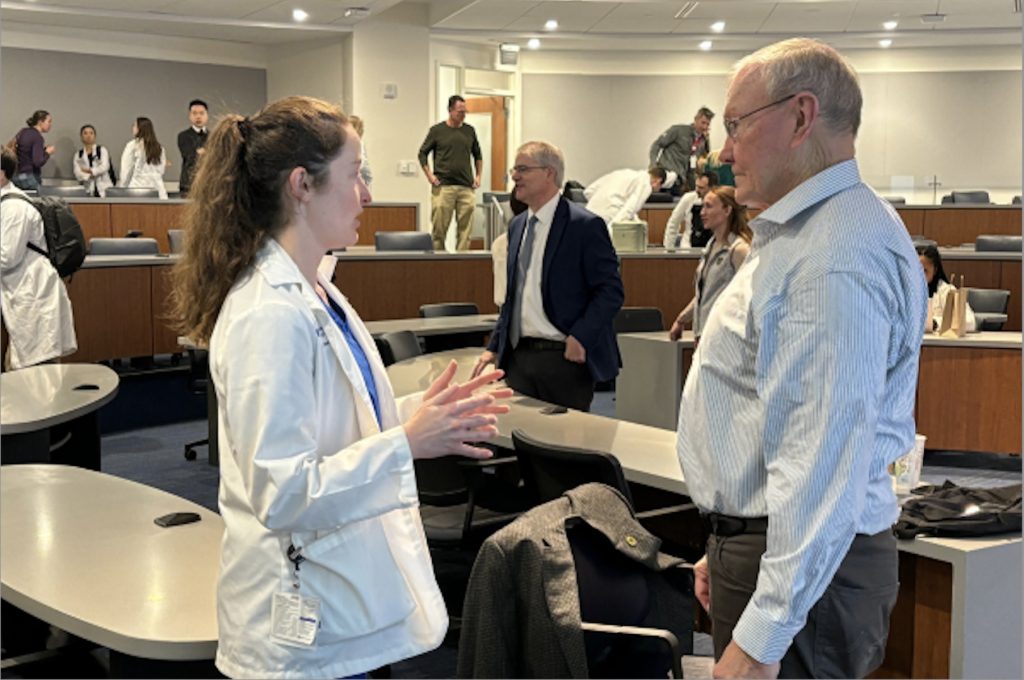On November 6, Duke Orthopaedics was honored to host Gen. Martin E. Dempsey (Ret.), former Chairman of the 18th Joint Chiefs of Staff and best-selling author, as the Veterans Day Visiting Professor at its Grand Rounds. In a captivating session, Gen. Dempsey shared insights from his illustrious military career, his work with USA Basketball, and his approach to leadership—captivating a room full of eager minds from the Duke community.
Leadership: Aspiring to Make a Memorable Impact
Gen. Dempsey’s message to the audience was clear: aspire to be a memorable leader. Reflecting on his own experiences, he recounted how soldiers in Iraq often approached him to share a specific moment or interaction they remembered, moments that Gen. Dempsey himself might not recall but which had left a lasting impression on them. This, he emphasized, was an essential aspect of leadership—creating positive, meaningful memories for those you lead.
“You should always ask yourself, ‘What do I want that person to remember about this day?’” Gen. Dempsey said. “People expect their leaders to be the best, the expert, and to care about them.”
Gen. Dempsey’s commitment to creating memorable moments extended beyond casual interactions. During his time in Iraq, he partnered with the chaplain for the First Armored Division to create a small pocketbook filled with “thoughts of the day” for his battalion. This initiative, he said, reflected a broader leadership philosophy—leaders must be both competent and of strong character to be effective.
Vision and Relentlessness: The Hallmarks of Leadership
During his talk, Gen. Dempsey also shared a powerful metaphor to highlight the visionary aspect of leadership. He recalled a recent trip to Ireland with his family, where he photographed a lighthouse window that offered a panoramic view of the horizon, used by a light keeper to monitor changes in weather and landscape and warn approaching ships. He drew a parallel between the light keeper’s role and the role of a leader: “Just like the light keeper, leaders need this vision—to know what you bring to your profession and anticipate what’s coming next.”
However, perhaps the most compelling lesson Dempsey shared was the importance of relentlessness in leadership. He showed a dramatic photo of a U.S. Marine, Paul E. Ison, charging up a beach in Okinawa, a moment captured during the intense battle at “Death Valley.” Despite the tremendous risks, Ison’s act was driven by a relentless determination to push through fear and find solutions even in the most dangerous situations.
“Relentlessness means not passing up a problem without offering a solution,” Dempsey explained. “Leaders give their best advice, even when it’s unpopular. It’s okay to get fired for doing what’s right.”

Leadership in Action: Hard Choices and Unpopular Solutions
Dempsey also discussed the difficult decisions he faced during his time in military leadership. A prime example came in 2011 when President Obama sought to withdraw U.S. troops from Iraq while ISIS was rapidly overrunning the U.S. consulate. With limited options, Dempsey gave the President two potential courses of action: using airpower or evacuating the consulate. The decision to use airpower ultimately succeeded, but Dempsey acknowledged that the choice was not universally endorsed—and that his willingness to make complex, unpopular decisions was a hallmark of leadership.
“Sometimes, doing hard things isn’t easy,” Dempsey said. “When someone says, ‘This is hard,’ your response should be, ‘Yep. Let’s do hard—better.'”
He added that this philosophy is often embodied by veterans and individuals with physical or mental disabilities, who are uniquely capable of doing “hard” things with resilience and determination.
Leadership in Action: Hard Choices and Unpopular Solutions
Dempsey also discussed the difficult decisions he faced during his time in military leadership. A prime example came in 2011 when President Obama sought to withdraw U.S. troops from Iraq while ISIS was rapidly overrunning the U.S. consulate. With limited options, Dempsey gave the President two potential courses of action: using airpower or evacuating the consulate.” The decision to use airpower ultimately succeeded, but Dempsey acknowledged that the choice was not universally endorsed—and that his willingness to make complex, unpopular decisions was a hallmark of leadership.
“Sometimes, doing hard things isn’t easy,” Dempsey said. “When someone says, ‘This is hard,’ your response should be, ‘Yep. Let’s do hard—better.'”
He added that this philosophy is often embodied by veterans and individuals with physical or mental disabilities, who are uniquely capable of doing “hard” things with resilience and determination.
A Call to Unity and Optimism
As the lecture drew to a close, Gen. Dempsey pivoted to a broader, more personal message—unity and optimism in the face of challenge. He acknowledged the country’s uncertainty and division after a contentious election season. Yet, he stressed the importance of “oneness” and the ability to choose optimism over pessimism to pursue a greater good.
“On Veteran’s Day, we honor the commitment, loyalty, and service of those who served our nation,” Dempsey reflected. “But more than that, we must ask ourselves: how will we make this moment matter? Will we unite, focus on our shared values, and strive to improve this country?”
Dempsey’s words resonated with everyone in the room. They offered a timely reflection on leadership and a call to action for all—leaders and followers alike—to step up with resolve, optimism, and a shared commitment to making a positive impact.
Conclusion
Gen. Martin Dempsey’s visit to Duke Orthopaedics on November 6 was more than just a lecture—it was a masterclass in leadership, filled with lessons learned from a lifetime of service to the nation and the broader community. As faculty and students processed his wisdom, it became clear that the principles of leadership he shared—memorable impact, relentlessness, vision, and unity—are not confined to the military but can inspire leaders in all fields to make a lasting difference.



Leave a Reply